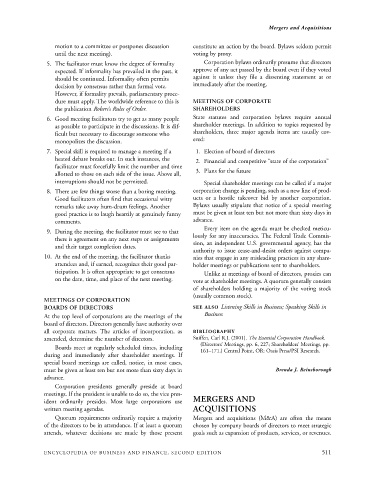Page 534 - Encyclopedia of Business and Finance
P. 534
eobf_M 7/5/06 3:15 PM Page 511
Mergers and Acquisitions
motion to a committee or postpones discussion constitute an action by the board. Bylaws seldom permit
until the next meeting). voting by proxy.
5. The facilitator must know the degree of formality Corporation bylaws ordinarily presume that directors
expected. If informality has prevailed in the past, it approve of any act passed by the board even if they voted
should be continued. Informality often permits against it unless they file a dissenting statement at or
decision by consensus rather than formal vote. immediately after the meeting.
However, if formality prevails, parliamentary proce-
dure must apply. The worldwide reference to this is MEETINGS OF CORPORATE
the publication Robert’s Rules of Order. SHAREHOLDERS
6. Good meeting facilitators try to get as many people State statutes and corporation bylaws require annual
as possible to participate in the discussions. It is dif- shareholder meetings. In addition to topics requested by
ficult but necessary to discourage someone who shareholders, three major agenda items are usually cov-
monopolizes the discussion. ered:
7. Special skill is required to manage a meeting if a 1. Election of board of directors
heated debate breaks out. In such instances, the
2. Financial and competitive “state of the corporation”
facilitator must forcefully limit the number and time
3. Plans for the future
allotted to those on each side of the issue. Above all,
interruptions should not be permitted. Special shareholder meetings can be called if a major
8. There are few things worse than a boring meeting. corporation change is pending, such as a new line of prod-
Good facilitators often find that occasional witty ucts or a hostile takeover bid by another corporation.
remarks take away hum-drum feelings. Another Bylaws usually stipulate that notice of a special meeting
good practice is to laugh heartily at genuinely funny must be given at least ten but not more than sixty days in
comments. advance.
Every item on the agenda must be checked meticu-
9. During the meeting, the facilitator must see to that
lously for any inaccuracies. The Federal Trade Commis-
there is agreement on any next steps or assignments
sion, an independent U.S. governmental agency, has the
and their target completion dates.
authority to issue cease-and-desist orders against compa-
10. At the end of the meeting, the facilitator thanks nies that engage in any misleading practices in any share-
attendees and, if earned, recognizes their good par- holder meetings or publications sent to shareholders.
ticipation. It is often appropriate to get consensus Unlike at meetings of board of directors, proxies can
on the date, time, and place of the next meeting. vote at shareholder meetings. A quorum generally consists
of shareholders holding a majority of the voting stock
(usually common stock).
MEETINGS OF CORPORATION
BOARDS OF DIRECTORS SEE ALSO Listening Skills in Business; Speaking Skills in
Business
At the top level of corporations are the meetings of the
board of directors. Directors generally have authority over
all corporate matters. The articles of incorporation, as BIBLIOGRAPHY
amended, determine the number of directors. Sniffen, Carl R.J. (2001). The Essential Corporation Handbook.
(Directors’ Meetings, pp. 6, 227; Shareholders’ Meetings, pp.
Boards meet at regularly scheduled times, including
161–171.) Central Point, OR: Oasis Press/PSI Research.
during and immediately after shareholder meetings. If
special board meetings are called, notice, in most cases,
must be given at least ten but not more than sixty days in Brenda J. Reinsborough
advance.
Corporation presidents generally preside at board
meetings. If the president is unable to do so, the vice pres-
ident ordinarily presides. Most large corporations use MERGERS AND
written meeting agendas. ACQUISITIONS
Quorum requirements ordinarily require a majority Mergers and acquisitions (M&A) are often the means
of the directors to be in attendance. If at least a quorum chosen by company boards of directors to meet strategic
attends, whatever decisions are made by those present goals such as expansion of products, services, or revenues.
ENCYCLOPEDIA OF BUSINESS AND FINANCE, SECOND EDITION 511

